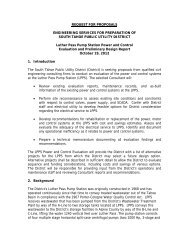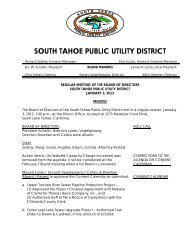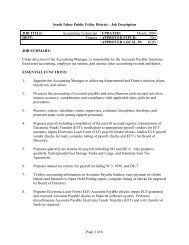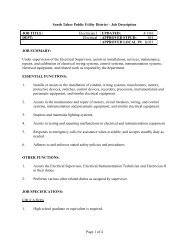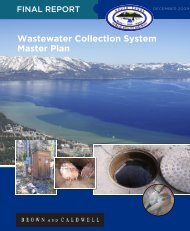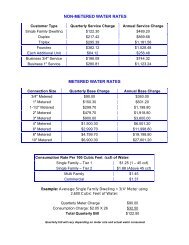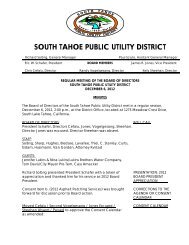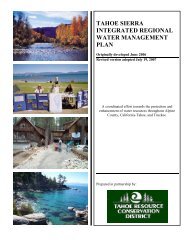October 2009 - South Tahoe Public Utility District
October 2009 - South Tahoe Public Utility District
October 2009 - South Tahoe Public Utility District
Create successful ePaper yourself
Turn your PDF publications into a flip-book with our unique Google optimized e-Paper software.
Section 10: Recycled Water Management Projects<br />
The <strong>District</strong> should develop and adopt a series of revised management and operation<br />
techniques to meet the objectives of recycled water management. The recycled water<br />
management projects have been separated from the infrastructure projects for clarity in<br />
understanding of the scope of the projects and how they integrate with the infrastructure<br />
projects. Although some administrative and operational costs may be entailed by the<br />
implementation of some of these management projects, itemized cost estimates were not<br />
developed for these projects.<br />
There are a total of three recycled water management projects. Two of these are recommended<br />
for implementation in the near future. The implementation of the third project is contingent on<br />
the need for additional recycled water irrigation land.<br />
10.1 Project No. 11 - Prepare Nutrient Management Plans<br />
This project addresses the purpose and need statement:<br />
<br />
PN-3. Potential exists for nitrate accumulation in groundwater with unregulated recycled<br />
water application rates.<br />
The recycled water application rate is founded upon a database containing irrigated lands, soil<br />
types, crop type and topographical and environmental data. The ultimate goal of California‟s<br />
Recycled Water Policy, currently under development, is to provide an incentive for development<br />
of salt (including nutrient) management plans by recycled water dischargers in groundwater<br />
basins that are threatened by salts. The intent of the Water Board in developing salt<br />
management plans is to assist irrigators in developing the irrigation requirements to meet crop<br />
demand, understand nitrogen limits, and protect groundwater by not exceeding the permeability<br />
limits. Application rates are discussed in greater detail in Appendix K.<br />
Project No. 11 of the Master Plan, Prepare Nutrient Management Plans, is recommended to be<br />
implemented because it will establish the appropriate recycled water application rate for each of<br />
the contract irrigator ranches. Although the Recycled Water Policy could potentially only require<br />
development of a single Nutrient Management Plan (NMP) for the basin, it is in the <strong>District</strong>‟s<br />
best interest to assist in preparation of the NMPs in coordination with each contract irrigator and<br />
educate the contract irrigators of the requirements of the NMP. The NMP recycled water<br />
irrigation application rate information can be used to modify the “effluent contract” for each<br />
contract irrigator and in turn, each contract irrigator‟s Lahontan Regional Water Quality Control<br />
Board permit for application of recycled water.<br />
10.2 Project No. 12 - Permitting for Recycled Water Use in<br />
Diamond Valley<br />
This project addresses the purpose and need statements:<br />
<br />
<br />
PN-1. Inadequate land may be available to apply future recycled water flows.<br />
PN-2. Residential development is encroaching on agricultural land, reducing land<br />
available for recycled water irrigation.<br />
<strong>South</strong> <strong>Tahoe</strong> <strong>Public</strong> <strong>Utility</strong> <strong>District</strong><br />
Recycled Water Facilities Master Plan - <strong>October</strong> <strong>2009</strong> Page 10-77



